Introduction
Imagine exploring breathtaking landscapes, immersing yourself in vibrant cultures, and creating unforgettable memories – all while leaving a positive footprint on the planet. This isn't just a dream; it's the reality of sustainable travel, and it's becoming the smartest way to see the world.
But what exactly is sustainable tourism, and how can you become a more conscious traveler? Let's dive into the world of responsible exploration and uncover how you can make your next adventure truly meaningful, for yourself and for the places you visit.
What is Sustainable Tourism?
Sustainable tourism is about traveling in a way that respects and benefits both the environment and local communities. It's a conscious shift away from mass tourism, which often prioritizes profit over preservation, leading to overcrowded destinations, environmental damage, and cultural dilution.
Think of it this way:
- Mass Tourism: Like a fast-food chain – efficient and affordable, but often lacking in quality, and with a significant environmental and social cost.
- Sustainable Tourism: More like a farm-to-table restaurant – focused on quality, local ingredients, and supporting the community, even if it requires a bit more thought and effort.
Sustainable tourism aims to minimize the negative impacts of travel and maximize the positive ones. It's about ensuring that future generations can enjoy the same wonders we do today.
Mass Tourism vs. Sustainable Tourism
For decades, mass tourism has been the dominant model. It's characterized by:
- Large Crowds: Think hordes of tourists overwhelming popular sites, diminishing the experience for everyone.
- Environmental Strain: Increased pollution, habitat destruction, and resource depletion due to sheer volume.
- Cultural Disconnect: Superficial interactions with local cultures, often turning authentic experiences into staged performances.
- Economic Leakage: Profits often flow to large international corporations, with limited benefits for local communities.
Sustainable Tourism, on the other hand, offers a different path. It champions:
- Respect for Nature: Protecting ecosystems, conserving resources, and minimizing pollution.
- Support for Local Communities: Empowering local economies, respecting cultural heritage, and creating authentic experiences.
- Responsible Travel Practices: Making conscious choices about transportation, accommodation, and consumption.
- Meaningful Experiences: Deeper connections with destinations, cultures, and people.
Ready to choose the sustainable path? Here are your tips below:
Top 10 Tips to Start Traveling More Sustainably in 2025
1. Make Mindful Transportation Choices: The Road to Sustainability Starts Here

Your journey's carbon footprint begins the moment you decide how to travel. While flying is sometimes unavoidable, consider the most eco-friendly options for getting around, especially for ground travel.
Here's a surprising sustainable travel tip: think about hiring a professional driver. Yes, you read that right. In today's world, where sustainability is key, opting for a professional driver service like driveronhire.com can be a remarkably mindful choice for ground transportation.
Why? Because professional drivers are experts in:
- Efficient Route Planning: They use their knowledge and advanced tools to navigate the most direct and fuel-saving paths, reducing unnecessary mileage and wasted fuel. Imagine bypassing traffic jams and taking optimized routes you might not even know exist!
- Fuel-Efficient Driving Practices: They are trained in techniques like maintaining steady speeds, avoiding harsh acceleration and braking, and anticipating traffic flow. These habits drastically cut down on fuel consumption compared to less experienced or rushed drivers.
- Well-Maintained, Fuel-Efficient Fleets: Services like Driveronhire.com often prioritize modern fleets with fuel-efficient vehicles, further minimizing the environmental impact per mile.
By choosing an outstation driver, you're not just getting from point A to B; you're actively choosing a sustainable ground transportation option that minimizes your carbon footprint and contributes to eco-friendly travel.
2. Travel During Off-Peak Times: Beat the Crowds, Benefit the Planet
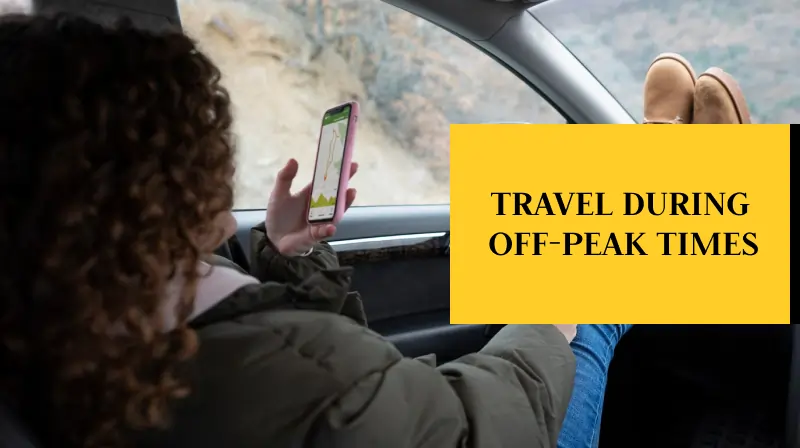
Dreaming of quieter streets and more authentic experiences? Travel during the off-season or less popular times.
This simple shift can have a surprisingly powerful impact on responsible tourism. Off-peak travel:
- Reduces Strain on Resources: Lessens the burden on local infrastructure, water supplies, and waste management systems that are often overwhelmed during peak tourist seasons.
- Supports a Balanced Tourism Model: Distributes tourism revenue more evenly throughout the year, providing more consistent income for local businesses and communities, rather than boom-and-bust cycles.
- Enhances Your Experience: Enjoy less crowded attractions, more personal interactions with locals, and often, lower prices!
Think about visiting that stunning beach destination in the shoulder season, or exploring a bustling city during the weekdays instead of peak weekends. You'll not only have a richer, more enjoyable trip, but you'll also be contributing to a more sustainable tourism model. Check out this website which helps predict the best times to avoid the crowds.
3. Choose Sustainable Accommodations and Operators: Vote with Your Bookings
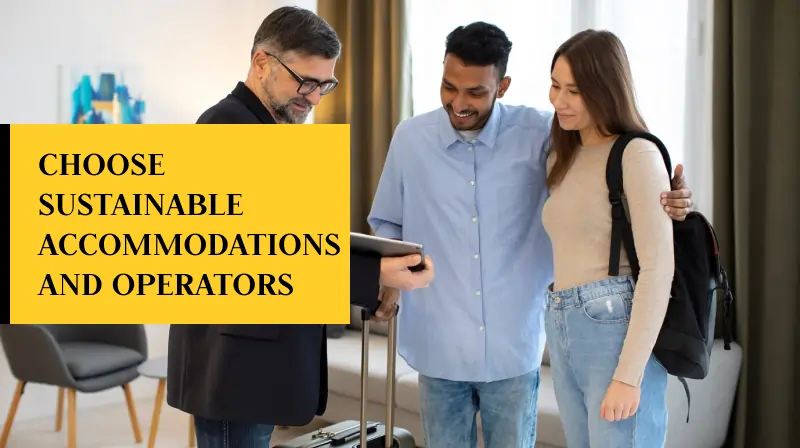
Your commitment to sustainability shouldn't stop at transportation. Extend your mindful choices to where you stay and who you book your tours with.
Seek out accommodations and tour operators that are genuinely committed to sustainability. Look for:
- Eco-Certified Hotels & Guesthouses: These establishments have met specific environmental standards, often focusing on energy and water conservation, waste reduction, and responsible sourcing.
- Locally-Owned Guesthouses & Homestays: Staying local often means your money directly benefits the community and supports local economies, while often offering a more authentic cultural experience.
- Tour Companies with Strong Environmental and Community Initiatives: Choose operators that prioritize small group tours, respect local cultures, minimize environmental impact, and contribute to local conservation efforts.
By actively choosing sustainable accommodations and operators, you send a powerful message to the tourism industry. You're telling them that travelers value eco accommodation and responsible tourism practices, encouraging more businesses to adopt sustainable models.
4. Choose a Fuel-Efficient Vehicle: Every Drop Counts

When ground travel is essential, opting for a fuel-efficient vehicle is non-negotiable for green travel. This is a cornerstone of sustainable transportation.
For services like Driveronhire.com, prioritizing a fleet of fuel-efficient vehicles is not just good for the environment; it's a smart business practice. It directly translates to:
- Lower Environmental Impact: Reducing carbon emissions per mile driven, contributing to cleaner air and a healthier planet.
- Cost Savings: Lower fuel consumption means reduced operating costs, which can be passed on to customers or reinvested in further sustainability initiatives.
- Demonstrated Commitment to Green Travel: Fuel-efficient fleets showcase a tangible commitment to environmentally conscious solutions, attracting eco-minded customers.
Whether you're renting a car or using a driver service, always inquire about fuel-efficient vehicle options. Every choice towards fuel efficiency makes a difference in reducing your carbon footprint.
5. Map Out Your Route (Efficiently): Drive Smarter, Not Harder
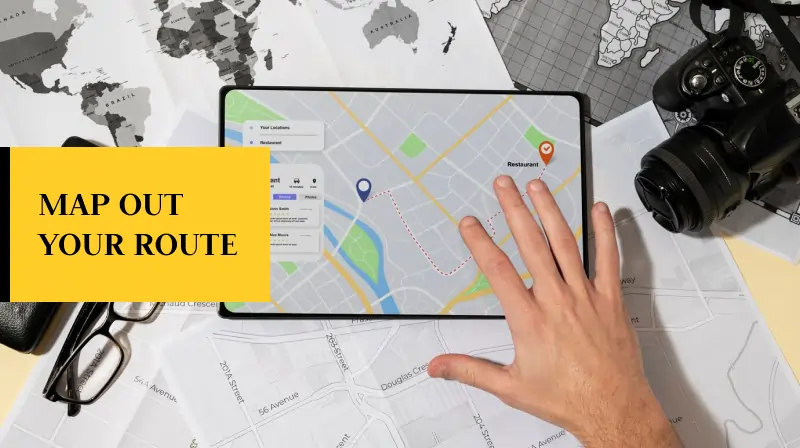
The efficiency of your route is another often-overlooked factor in sustainable driving. Wasted miles mean wasted fuel and unnecessary emissions.
This is where the expertise of professional drivers truly shines. They excel at:
- Leveraging Navigation Technology: Using real-time traffic data and advanced GPS systems to identify the most direct and quickest routes.
- Local Knowledge: Understanding local road networks, traffic patterns, and shortcuts that navigation apps might miss.
- Proactive Route Planning: Considering factors like time of day, weather conditions, and potential road closures to optimize routes in advance.
By utilizing their skills and tools to plan the most direct and fuel-saving paths, professional drivers minimize unnecessary mileage and fuel consumption, embodying the value of skilled drivers in eco-conscious travel. You benefit from a faster, smoother journey, and the planet benefits from reduced emissions.
6. Drive Efficiently: It's Not Just the Car, It's How You Drive It

Beyond the vehicle and the route, the way you drive is crucial for sustainable transportation. Even the most fuel-efficient car can guzzle gas with inefficient driving habits.
Efficient driving is about smooth, controlled movements:
- Maintain Steady Speeds: Avoid unnecessary speeding and constant changes in pace. Cruise control on highways can be your best friend.
- Avoid Harsh Acceleration and Braking: Gentle acceleration and braking conserve fuel and reduce wear and tear on your vehicle.
- Anticipate Traffic Flow: Look ahead and anticipate traffic lights and slowdowns to avoid unnecessary braking and acceleration.
- Proper Tire Inflation: Ensure your tires are inflated to the recommended pressure to reduce rolling resistance and improve fuel economy.
Professional drivers are trained in these efficient driving techniques, making their expertise a key contribution to minimizing the environmental footprint of each journey. By adopting these habits yourself, whether you're driving or being driven, you can significantly improve fuel efficiency and reduce emissions.
7. Eat Local and Sustainable: Taste the Place, Support the People
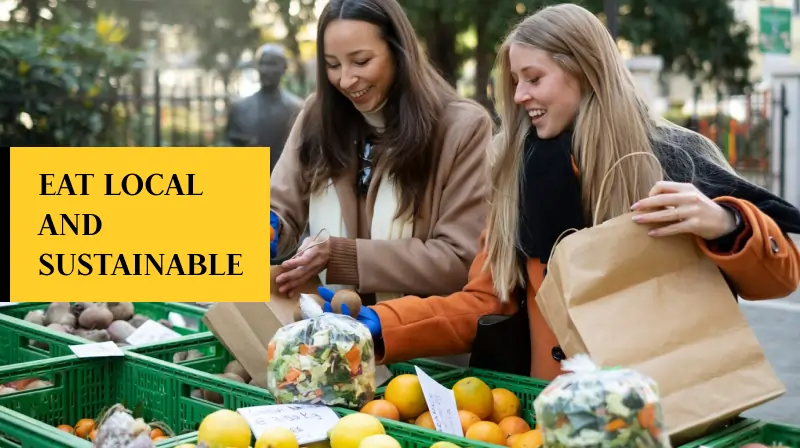
Sustainable travel isn't just about transportation; it's also deeply connected to what you consume. Food is a significant part of your travel experience, and your choices here matter.
Prioritize eating at local restaurants and choosing food sourced sustainably. This simple act:
- Reduces Food Miles: Minimizes the carbon footprint associated with long-distance food transportation, as local ingredients travel shorter distances.
- Supports Local Farmers and Economies: Keeps your money within the community, supporting local livelihoods and preserving traditional food production methods.
- Offers Authentic Culinary Experiences: Discover the unique flavors and dishes of your destination, experiencing the local culture through its cuisine.
Seek out farmers' markets, family-run restaurants, and eateries that highlight local and seasonal ingredients. Eating local and sustainable is a delicious way to contribute to responsible tourism and immerse yourself in the heart of your destination.
8. Support Local Businesses: Shop with a Purpose

Extend your support for local communities beyond just food. Whenever possible, choose to shop at local businesses, markets, and artisan shops.
Supporting local businesses is a powerful way to:
- Inject Money Directly into the Local Economy: Ensuring that tourism revenue benefits the people who live in the destination, rather than just large corporations.
- Help Communities Thrive: Supporting local businesses helps sustain livelihoods, create jobs, and strengthen the local economy.
- Preserve Local Culture and Traditions: Local businesses often showcase unique crafts, products, and traditions that are integral to the cultural identity of a place.
- Find Unique and Authentic Souvenirs:Skip the mass-produced trinkets and discover handcrafted treasures that tell a story and support local artisans.
From handcrafted souvenirs to locally made clothing, supporting local businesses while traveling enriches your experience and contributes to the ethical travel and well-being of the communities you visit.
9. Reduce Plastic Waste: Travel Light, Leave Lightly

Plastic waste is a global environmental crisis, and as a traveler, you have a crucial role to play in minimizing your contribution.
Actively minimize your plastic waste by adopting these simple habits:
- Carry a Reusable Water Bottle: Refill it throughout your day and avoid buying single-use plastic bottles.
- Bring a Reusable Coffee Cup: Say no to disposable coffee cups and enjoy your morning brew in your own eco-friendly cup.
- Pack a Reusable Shopping Bag: Decline plastic bags at markets and shops and use your own reusable bag.
- Choose Products with Minimal Packaging: Opt for items with less plastic packaging or consider package-free alternatives when possible.
- Properly Dispose of Unavoidable Plastic Waste: When you do encounter plastic waste, make sure to dispose of it responsibly in designated recycling bins whenever available.
Reducing plastic waste while traveling is a tangible way to protect our oceans, landscapes, and wildlife, contributing to a cleaner and healthier planet for everyone.
10. Respect Wildlife and Natural Habitats: Leave Only Footprints, Take Only Memories
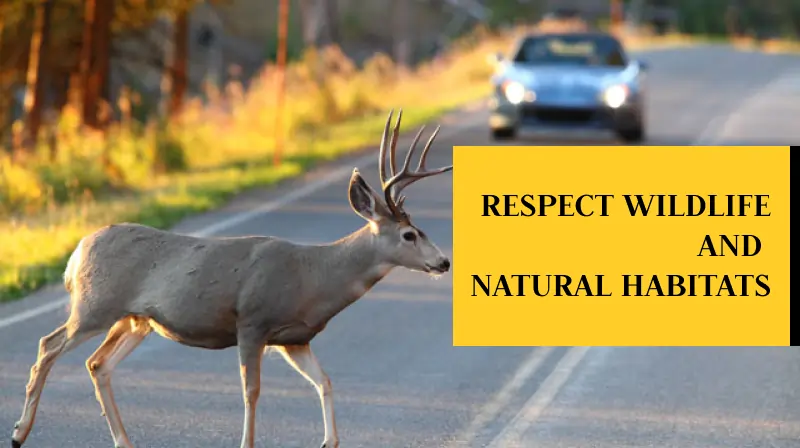
Responsible travel fundamentally means being a respectful visitor to the natural world. Our actions can have a significant impact on delicate ecosystems and wildlife.
Respect wildlife and natural habitats by following these guidelines:
- Observe Wildlife from a Safe Distance:Maintain a respectful distance and avoid disturbing animals in their natural environment.
- Never Feed Animals:Feeding wildlife can disrupt their natural feeding habits and make them dependent on humans.
- Stay on Marked Trails: Avoid venturing off designated paths, which can damage fragile vegetation and habitats.
- Avoid Disturbing Natural Habitats: Refrain from picking flowers, collecting rocks, or removing anything from natural environments. Choose Wildlife-Friendly Activities: Opt for ethical wildlife tours that prioritize animal welfare and conservation.
- Choose Wildlife-Friendly Activities: Opt for ethical wildlife tours that prioritize animal welfare and conservation.
By respecting wildlife and natural habitats, you ensure the preservation of biodiversity and the beauty of natural destinations for generations to come. Let's be mindful guests in the natural world, leaving it as pristine as we found it.
Bonus Tip: Offset Your Carbon Footprint: Take Responsibility, Give Back
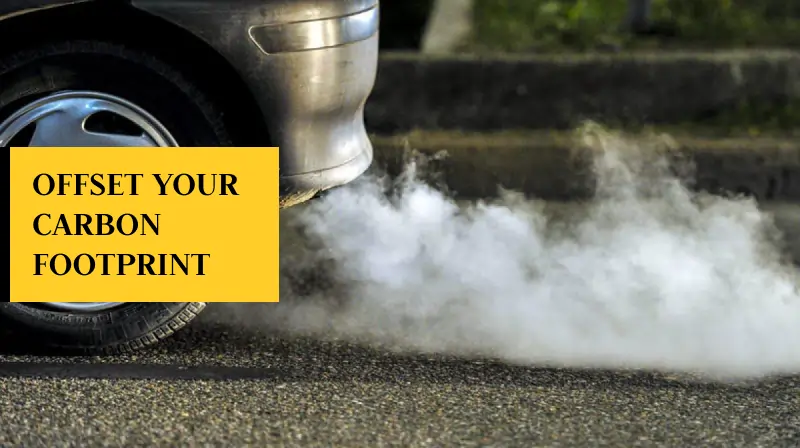
While reducing your carbon footprint through mindful choices is the primary goal, offsetting unavoidable emissions is a valuable additional step.
Consider using reputable carbon offsetting programs that invest in environmental projects, such as:
- Reforestation: Planting trees to absorb carbon dioxide from the atmosphere.
- Renewable Energy Initiatives: Supporting projects that develop and promote clean energy sources.
- Community-Based Conservation: Investing in projects that protect forests, wetlands, or other vital ecosystems while benefiting local communities.
Offsetting your carbon footprint acknowledges the impact of travel and contributes to mitigating its effects. It's a way to take responsibility for your emissions and support positive environmental action.
Conclusion
Sustainable travel isn't about sacrificing experiences; it's about enhancing them. It's about traveling with intention, making conscious choices that benefit both you and the world around you.
By embracing these top 10 tips for sustainable travel, you can embark on adventures that are not only unforgettable but also contribute to a healthier planet and more vibrant communities. And for your ground transportation needs, remember that Driveronhire.com is committed to providing sustainable ground transportation solutions, helping you drive greener and explore better.
Start planning your next eco-friendly trip today, and discover the profound rewards of responsible tourism. The world awaits, and it's counting on us to explore it sustainably.
FAQ
Q.1: How can travel be more environmentally sustainable?
Travel becomes more sustainable by choosing fuel-efficient or electric transportation, planning optimized routes, reducing waste, and supporting eco-friendly accommodations and local businesses. Offset your carbon emissions whenever possible to further minimize your impact.
Q.2: What are eco-friendly tourism practices?
Eco-friendly tourism practices include using sustainable transport options, staying at green-certified accommodations, minimizing plastic and other waste, conserving water and energy, and engaging in activities that respect and support local ecosystems and cultures.
Q.3: How do I travel sustainably and responsibly?
Sustainable and responsible travel involves careful planning—selecting eco-friendly transportation and lodging, traveling during off-peak times, supporting local economies, reducing waste, and respecting cultural and natural resources throughout your journey.
Q.4: What is the most environmentally friendly method of travel?
For short trips, walking, cycling, or using public transport are ideal. For longer journeys, opting for fuel-efficient or electric vehicles, or even using professional driver services that optimize routes and driving habits, can greatly reduce environmental impact.
Q.5: Why should I travel eco-friendly?
Eco-friendly travel helps protect natural resources, reduces pollution, and supports local communities. It ensures that destinations remain vibrant and culturally intact for future generations, while also offering a more authentic and mindful travel experience.
Q.6: Can you give an example of sustainable travel?
A practical example is a road trip using a fuel-efficient vehicle, where you stay at eco-certified accommodations, eat locally sourced food, minimize waste, and plan your route to reduce unnecessary mileage—all while considering carbon offset options.
Q.7: What are the 5 P's of sustainable tourism?
The 5 P's are People, Planet, Profit, Peace, and Purpose. This framework encourages travel that benefits local communities (People), protects the environment (Planet), supports sustainable economic practices (Profit), fosters harmonious experiences (Peace), and creates meaningful journeys (Purpose).
Q.8: What is responsible traveling?
Responsible traveling means making mindful decisions that minimize harm to the environment and local cultures. It involves respecting local customs, reducing waste, supporting conservation efforts, and ensuring that your visit has a positive, lasting impact on the destination.
Q.9: How can eco-friendly road trips contribute to sustainable travel?
Eco-friendly road trips use strategies like selecting fuel-efficient vehicles, optimizing travel routes, and driving with efficient habits. They also support local economies by choosing local stops and reducing the environmental footprint through lower emissions and less waste.
Q.10: What are some top eco-friendly travel destinations in India?
India offers a diverse range of sustainable travel experiences. For nature lovers near Mumbai, Sanjay Gandhi National Park provides a green retreat with well-managed trails and eco-friendly initiatives. Beyond the metropolitan area, destinations like Kerala's backwaters and eco-resorts, Sikkim’s pristine mountain landscapes with strict environmental policies, Auroville in Tamil Nadu for sustainable living, and the Andaman & Nicobar Islands with their focus on marine conservation showcase India's commitment to eco-friendly tourism. These places not only emphasize conservation and community engagement but also provide authentic cultural and natural experiences for the mindful traveler.
